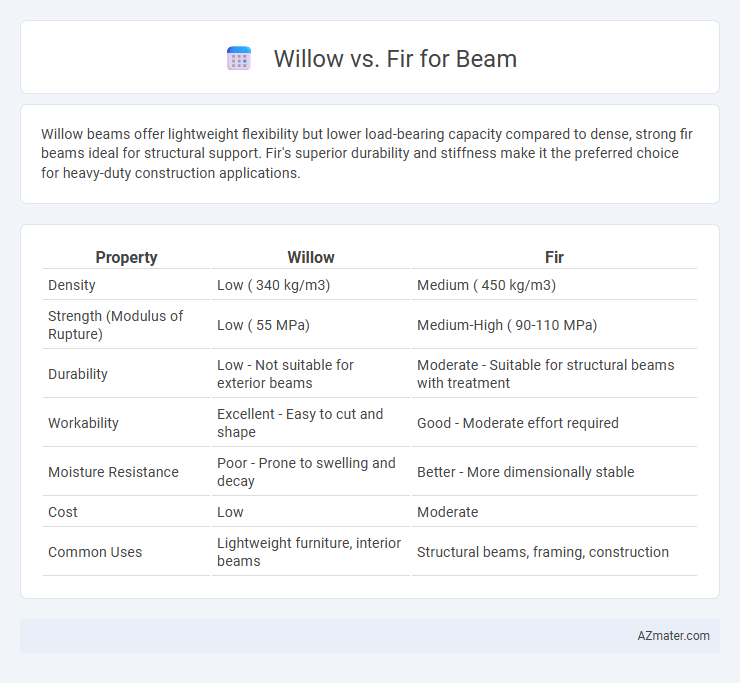Willow beams offer lightweight flexibility but lower load-bearing capacity compared to dense, strong fir beams ideal for structural support. Fir's superior durability and stiffness make it the preferred choice for heavy-duty construction applications.
Table of Comparison
| Property | Willow | Fir |
|---|---|---|
| Density | Low ( 340 kg/m3) | Medium ( 450 kg/m3) |
| Strength (Modulus of Rupture) | Low ( 55 MPa) | Medium-High ( 90-110 MPa) |
| Durability | Low - Not suitable for exterior beams | Moderate - Suitable for structural beams with treatment |
| Workability | Excellent - Easy to cut and shape | Good - Moderate effort required |
| Moisture Resistance | Poor - Prone to swelling and decay | Better - More dimensionally stable |
| Cost | Low | Moderate |
| Common Uses | Lightweight furniture, interior beams | Structural beams, framing, construction |
Introduction to Willow and Fir as Beam Materials
Willow and fir are commonly used timber species for beams due to their distinct structural properties and availability. Willow offers flexibility and lightweight characteristics, making it suitable for applications requiring moderate strength and ease of handling, while fir provides higher strength-to-weight ratio and excellent durability, ideal for heavy load-bearing beams in construction. Understanding the mechanical properties and environmental resistance of both woods assists builders in selecting the appropriate material based on specific architectural requirements.
Key Physical Properties: Willow vs Fir
Willow wood is lightweight with a low density of approximately 320 kg/m3, offering moderate strength and high flexibility, making it easy to work with but less suitable for heavy structural beams. Fir wood has a higher density near 530 kg/m3, providing superior compressive strength, stiffness, and durability, which makes it a popular choice for load-bearing beams in construction. The key physical properties highlight Fir's greater load resistance and stability compared to the softer, more pliable Willow.
Strength and Structural Performance Comparison
Fir beams exhibit superior strength and structural performance compared to willow, with a higher modulus of elasticity and greater load-bearing capacity. Willow's lower density and tensile strength limit its use in heavy-duty structural applications, making it more suitable for lightweight or decorative purposes. Fir's consistent grain and durability ensure enhanced stability and resistance to bending under stress in construction projects.
Durability and Longevity in Beams
Fir beams offer superior durability and longevity compared to willow due to their dense grain structure and natural resistance to warping and splitting. Willow, while lightweight and flexible, tends to have lower strength and is more susceptible to moisture damage and decay over time. Fir's robust cellular composition ensures it maintains structural integrity in load-bearing applications, making it a preferred choice for long-lasting beams.
Weight and Workability Considerations
Willow wood is significantly lighter than fir, with a density around 360 kg/m3 compared to fir's 530 kg/m3, making willow easier to handle and transport for beam construction. Fir offers superior strength and stiffness, but its higher weight increases labor intensity during installation. The workability of willow is enhanced by its softness and flexibility, whereas fir's hardness requires more effort to cut and shape, impacting overall project efficiency.
Moisture Resistance and Decay Factors
Willow wood exhibits lower moisture resistance compared to fir, making it more susceptible to swelling and warping in damp conditions. Fir offers better natural decay resistance due to its tighter grain structure and higher resin content, which inhibits fungal growth. For beam applications exposed to moisture, fir is preferred to enhance durability and reduce maintenance over time.
Cost Analysis: Willow vs Fir Beams
Willow beams typically cost less than fir beams, making them a budget-friendly option for construction projects. Fir beams offer greater durability and structural strength, which can justify their higher price in long-term applications. When comparing costs, consider not only the initial price per board foot but also maintenance expenses and lifespan to determine overall value.
Sustainability and Environmental Impact
Willow beams are highly sustainable due to their rapid growth and ability to regenerate quickly, making them an eco-friendly choice for construction. Fir beams offer durability and strength but have a longer growth cycle, resulting in a higher environmental footprint compared to willow. Choosing willow reduces deforestation pressure and supports carbon sequestration through fast biomass accumulation.
Best Applications for Willow and Fir Beams
Willow beams are best suited for lightweight structures and decorative applications due to their flexibility and resistance to splitting, making them ideal for curved or artistic designs. Fir beams offer superior strength and durability, making them the preferred choice for load-bearing elements in construction such as floor joists, roof trusses, and framing. Choosing between willow and fir beams depends on the specific structural requirements, with fir favored for heavy-duty support and willow for aesthetics and moderate load scenarios.
Conclusion: Choosing the Right Wood for Your Project
Willow wood offers lightweight flexibility but lacks the strength and durability needed for structural beams, making it unsuitable for heavy loads. Fir wood provides superior strength, stability, and resistance to warping, making it the optimal choice for beams in construction projects. Selecting fir ensures long-lasting support and safety, crucial factors in building reliable structures.

Infographic: Willow vs Fir for Beam
 azmater.com
azmater.com